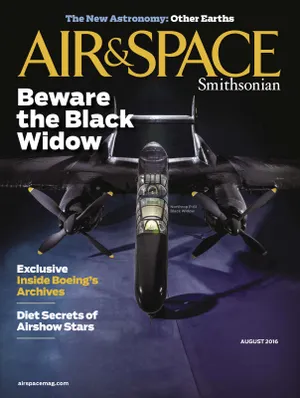Lindbergh’s Airplane (or a Close Replica) Takes to the Skies
At the Old Rhinebeck Aerodrome, it feels like 1927 all over again.
:focal(513x307:514x308)/https://tf-cmsv2-smithsonianmag-media.s3.amazonaws.com/filer/7c/c8/7cc8fbf6-8241-4675-91de-9e64a3803fc4/18b_aug2016_spirit_6_live.jpg)
As any student of aviation history knows, the Spirit of St. Louis hangs securely from the ceiling of the National Air and Space Museum in Washington, D.C., so seeing it in the air over upstate New York is likely to cause a double take. What’s double is the airplane: The Old Rhinebeck Aerodrome has created a near-perfect Spirit replica, which joins the antique and vintage aircraft flying there every weekend.
The Rhinebeck Spirit looks just like the original did when it rolled out of the Ryan factory, ready for Charles Lindbergh to hop in and fly across the Atlantic Ocean. But this Spirit will stick close to home.
The Rhinebeck Spirit made its public debut on May 20, 2016—exactly 89 years after Lindbergh took off on his epic flight from Long Island to Paris. It was the dream of Aerodrome founder Cole Palen, who died in 1993 with the project barely started. “Lindbergh was his hero, as he was to a lot of people, myself included,” says Ken Cassens, the Aerodrome’s chief mechanic and the builder (along with many volunteers) of the new Spirit.
Palen had the key ingredient: an original Wright J-5 Whirlwind engine. At the time of his death a fuselage and wing had been built, but when Cassens began work he found that the wing had been damaged by mice and the welding of the fuselage was subpar. “It was so bad, we started right over from scratch,” says Cassens. But starting anything with the Spirit isn’t just a matter of following a well-worn path: There are no original construction drawings.
A Ryan fabricator made a set of drawings in the 1950s, but in them, “the shape of the rudder wasn’t correct,” Cassens says. “The door frame and the windows were not properly proportioned.” With the help of the Museum, he got up close to the original—yes, still hanging from the Museum ceiling. “They took me up in the cherry picker to make measurements,” he says. “So we have it as accurate as possible.”All the instruments are duplicates of what Lindbergh used, laid out exactly as he had them, right down to the periscope (which Cassens pronounces “useless”) and the tiny mirror (to read the compass installed above his head). True to the original, the replica has no radio and no forward visibility—looking ahead requires “crabbing” the airplane to peer out a side window. Even the wicker seat is an exact duplicate.
But Cassens and team took some “poetic license,” he says. “We used modern materials wherever we could, so long as it didn’t distract from the overall appearance. We’re trying to make the airplane as durable as possible, because we want it flying here for a long time.” Instead of the original cotton fabric, the team used a fire-retardant synthetic. The engine exhaust stacks were made of stainless steel instead of carbon steel, which would rust. The rudder pedals and control column have grease fittings. Another modern addition, required by the Federal Aviation Administration: a fuel gauge. (Lindbergh calculated his fuel usage by writing hash marks on the instrument panel.) To keep the gauge off the panel, the builders tucked it away, but it’s clearly visible to the pilot. The replica’s big gas tank is for show; it can carry only 50 gallons of gas, enough to fly 400 miles.
Cassens test-flew the Spirit in December 2015, after training in the Aerodrome’s 1929 Curtiss Robin, with a sheet of cardboard blocking his forward view and a safety pilot in the front cockpit. After three or four hours of such training, Cassens was ready to fly the new Spirit. Last May 20, he took off in a graceful climb, nothing like Lindbergh’s agonizing lumber. It was the first of many performances he and the airplane will make, answering in sight, sound, and smell all those who wonder what it was like to see the original Spirit fly.
